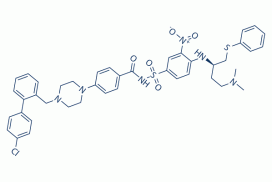This product is for research use only, not for human use. We do not sell to patients.

| Size | Price | Stock |
|---|---|---|
| 500mg | $1000 | Check With Us |
| 1g | $1500 | Check With Us |
Cat #: V0002 CAS #: 852808-04-9 Purity ≥ 98%
Description: ABT-737 is a novel, potent, selective and orally bioavailable BH3 mimetic inhibitor of Bcl-xL, Bcl-2 and Bcl-w with EC50 of 78.7 nM, 30.3 nM and 197.8 nM in enzymatic assays, respectively. It does not inhibit Mcl-1, Bcl-B or Bfl-1 etc.
References: [1] Konopleva M, et al. Mechanisms of apoptosis sensitivity and resistance to the BH3 mimetic ABT-737 in acute myeloid leukemia. Cancer Cell. 2006 Nov;10(5):375-88. [2] Ahamed Saleem, et al. Effect of dual inhibition of apoptosis and autophagy in prostate cancer. Prostate. 2012 Sep 1;72(12):1374-81.
Publications Citing InvivoChem Products
Product Promise

- Physicochemical and Storage Information
- Protocol
- Related Biological Data
- Stock Solution Preparation
- Quality Control Documentation
| Molecular Weight (MW) | 813.43 |
|---|---|
| Molecular Formula | C42H45ClN6O5S2 |
| CAS No. | 852808-04-9 |
| Storage | Powder -20°C 3 years 4°C 2 years In solvent -80°C 6 months -20°C 1 month |
| Solubility In Vitro | DMSO: 100 mg/mL (122.93 mM)rrrrrrrrrrr |
| Water: <1 mg/mL (slightly soluble or insoluble)rrrrrrrrrrr | |
| Ethanol: <1 mg/mL | |
| Solubility In Vivo | 30% Propylene glycol, 5% Tween 80, 65% D5W: 30mg/mL |
| SMILES Code | O=C(NS(=O)(C1=CC=C(N[C@H](CCN(C)C)CSC2=CC=CC=C2)C([N+]([O-])=O)=C1)=O) C3=CC=C(N4CCN(CC5=CC=CC=C5C6=CC=C(Cl)C=C6) CC4)C=C3 |
| Synonyms | ABT 737; ABT-737; ABT737 |
| Protocol | In Vitro | ABT-737 (100 nM; 1-72 hours) induces apoptosis and synergizes with chemotherapy in HL-60 cells. ABT-737 has no effect on cell cycle distribution. ABT-737 disrupts BCL-2/BAX heterodimerization and induces BAX conformational change in HL-60 leukemic cells. ABT-737 binds BCL-2, BCL-XL, and BCL-W ABT-737 binds BCL-2, BCL-XL, and BCL-W with high affinity (Ki<1 nM) but binds weakly (Ki>460 nM) to other antiapoptotic BCL-2 family members, including MCL-1 and BFL-1. ABT-737 binds the BH3-binding groove of BCL-XL and BCL-2. ABT-737 (5, 7.5, 10 μM; 72 hours) causes approximately 80% HCT116 cell death. The BAX knockout variant is completely resistant to ABT-737. |
|---|---|---|
| In Vivo | ABT-737 significantly extends survival of mice in this aggressive leukemia model. ABT-737 (20, 30 mg/kg/day; i.p.; for 21 days) suppresses the leukemia burden by 48% and 53% at the 20 and 30 mg/kg dose levels, respectively, in four- to six-week-old CB.17 Scid mice with human leukemia KG-1 cells. |
| Solvent volume to be added | Mass (the weight of a compound) | |||
|---|---|---|---|---|
| Mother liquor concentration | 1mg | 5mg | 10mg | 20mg |
| 1mM | 1.2294 mL | 6.1468 mL | 12.2936 mL | 24.5872 mL |
| 5mM | 0.2459 mL | 1.2294 mL | 2.4587 mL | 4.9174 mL |
| 10mM | 0.1229 mL | 0.6147 mL | 1.2294 mL | 2.4587 mL |
| 20mM | 0.0615 mL | 0.3073 mL | 0.6147 mL | 1.2294 mL |
This equation is commonly abbreviated as: C1 V1 = C2 V2
- (1) Please be sure that the solution is clear before the addition of next solvent. Dissolution methods like vortex, ultrasound or warming and heat may be used to aid dissolving.
- (2) Be sure to add the solvent(s) in order.




































